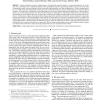Free Online Productivity Tools
i2Speak
i2Symbol
i2OCR
iTex2Img
iWeb2Print
iWeb2Shot
i2Type
iPdf2Split
iPdf2Merge
i2Bopomofo
i2Arabic
i2Style
i2Image
i2PDF
iLatex2Rtf
Sci2ools
VIS
2009
IEEE
2009
IEEE
Supercubes: A High-Level Primitive for Diamond Hierarchies
Abstract-- Volumetric datasets are often modeled using a multiresolution approach based on a nested decomposition of the domain into a polyhedral mesh. Nested tetrahedral meshes generated through the longest edge bisection rule are commonly used to decompose regular volumetric datasets since they produce highly adaptive crack-free representations. Efficient representations for such models have been achieved by clustering the set of tetrahedra sharing a common longest edge into a structure called a diamond. The alignment and orientation of the longest edge can be used to implicitly determine the geometry of a diamond and its relations to the other diamonds within the hierarchy. We introduce the supercube as a high-level primitive within such meshes that encompasses all unique types of diamonds. A supercube is a coherent set of edges corresponding to three consecutive levels of subdivision. Diamonds are uniquely characterized by the longest edge of the tetrahedra forming them and are clu...
| Added | 06 Nov 2009 |
| Updated | 14 Nov 2009 |
| Type | Conference |
| Year | 2009 |
| Where | VIS |
| Authors | Kenneth Weiss, Leila De Floriani |
Comments (0)

